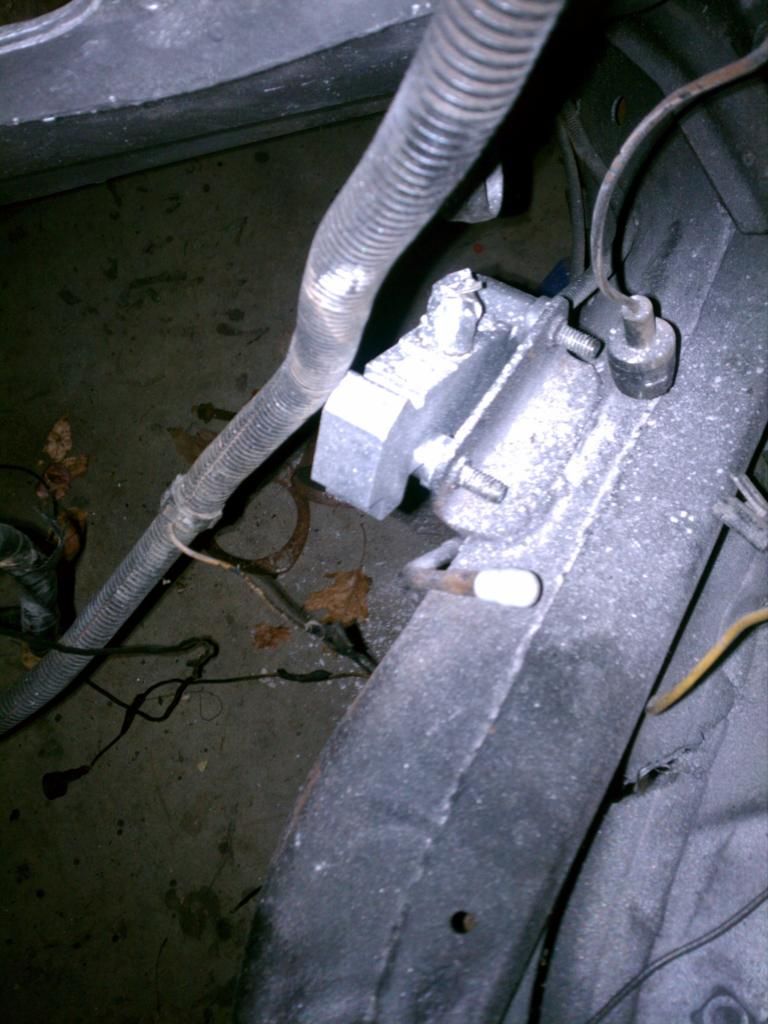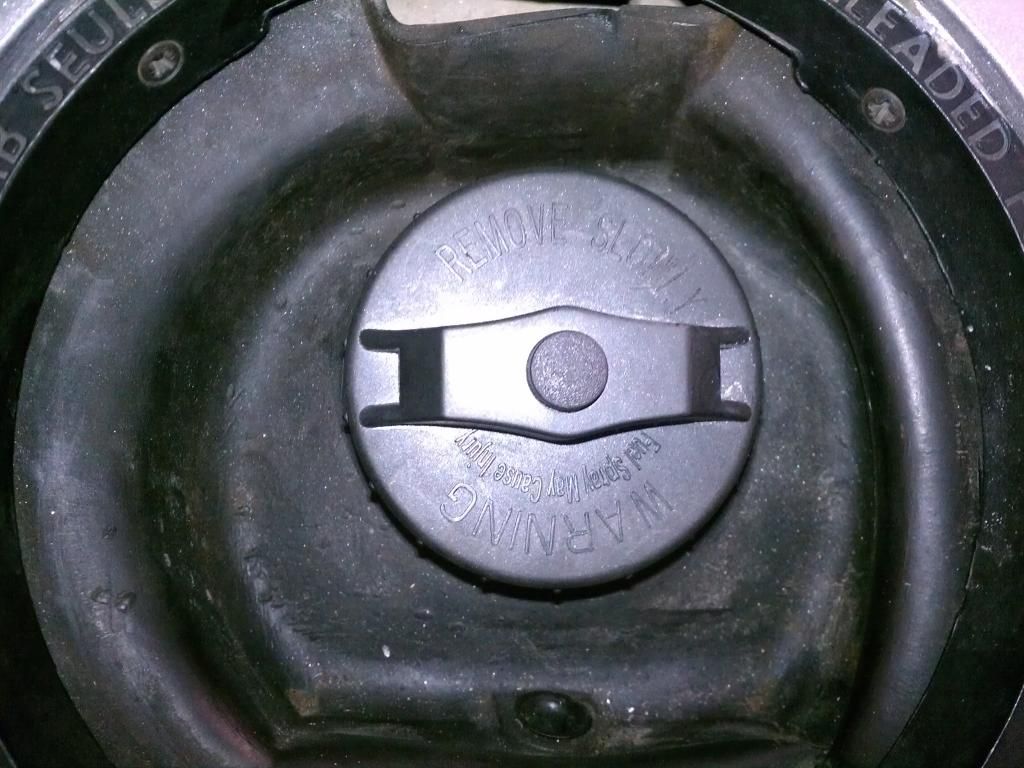Charcoal Canister - 1979
#21
Pro


Anyone else not using a vapor canister? If so, what did you end up doing? Curious if I should keep the fuel tank vent line connected, cap remaining ports and call it a day.
#22
Burning Brakes


Member Since: Nov 2004
Location: San Antonio Texas
Posts: 1,028
Likes: 0
Received 0 Likes
on
0 Posts

I suspect their definition of the "useful life of a vehicle" is far less that the 30 to 45+ years of the current C-3's. I was surprised to learn recently that the "average" life of a vehicle in the U.S. is about 8 years. This means that the "average" new vehicle sold in the U.S. is in the junk yard after about 8 years. Imagine that.
#23
Burning Brakes


It is very easy to remove the canister. It is merely held on by two rivits which can be ground off from the wheel well.
It may have bolts if someone worked on it before.
If you remove the can, you MUST block off the lines. There should be NO vent line at all. None, zero, zip, nada.
But you have to use a vented gas cap as shown above. Right now it is a closed system.
It is very easy to do with a vacuum plug available at any auto parts store. Usual sold in blister packs of a dozen or so different sizes for a couple of bucks.
Your line from the tank comes up next to the brake proportioning valve under the power steering booster. Simply place one of the vacuum plugs on it as shown here:

BTW, your fuel pump also has a gas tank vent line. If you decide to replace your fuel pump with an aftermarket one, you will need to use one of your newly bought vacuum plugs on this line as well.
#24
Pro


It is very easy to remove the canister. It is merely held on by two rivits which can be ground off from the wheel well.
It may have bolts if someone worked on it before.
If you remove the can, you MUST block off the lines. There should be NO vent line at all. None, zero, zip, nada.
But you have to use a vented gas cap as shown above. Right now it is a closed system.
It is very easy to do with a vacuum plug available at any auto parts store. Usual sold in blister packs of a dozen or so different sizes for a couple of bucks.
Your line from the tank comes up next to the brake proportioning valve under the power steering booster. Simply place one of the vacuum plugs on it as shown here:

BTW, your fuel pump also has a gas tank vent line. If you decide to replace your fuel pump with an aftermarket one, you will need to use one of your newly bought vacuum plugs on this line as well.
It may have bolts if someone worked on it before.
If you remove the can, you MUST block off the lines. There should be NO vent line at all. None, zero, zip, nada.
But you have to use a vented gas cap as shown above. Right now it is a closed system.
It is very easy to do with a vacuum plug available at any auto parts store. Usual sold in blister packs of a dozen or so different sizes for a couple of bucks.
Your line from the tank comes up next to the brake proportioning valve under the power steering booster. Simply place one of the vacuum plugs on it as shown here:

BTW, your fuel pump also has a gas tank vent line. If you decide to replace your fuel pump with an aftermarket one, you will need to use one of your newly bought vacuum plugs on this line as well.
#25
Burning Brakes


My charcoal canister is likely coming out soon so I'll be following this thread with you...
#26
Pro


No worries. The way I currently have it connected now apparently it doesn't function at all. I have a spare Canister and tested it with vacuum and you definitely need the Control Vac connected in order for the canister to purge the vapor/recycle it. So, with that being said, I will disconnect the remaining hoses and cap the ports on the canister. I will keep the fuel tank vent line connected and roll with that as in essence I've been doing that already for years with no issues or fuel smell.
#27
Burning Brakes


No worries. The way I currently have it connected now apparently it doesn't function at all. I have a spare Canister and tested it with vacuum and you definitely need the Control Vac connected in order for the canister to purge the vapor/recycle it. So, with that being said, I will disconnect the remaining hoses and cap the ports on the canister. I will keep the fuel tank vent line connected and roll with that as in essence I've been doing that already for years with no issues or fuel smell.
The canister and all associated plumbing can be removed with NO adverse affect to the environment or you car.
Plug the lines as detailed above and buy a vented cap. They are cheap insurance.
I would not want to run an open vent line to atmosphere for a number of reasons:
1. Gas will evaporate into the air directly.
2. You risk dirt and contaminants getting into your fuel
3. Liquid gas could slosh and splash out the tube.
4. The risk of fumes and flammable gas in the air around your car is very real.
This is the vented cap I use. It has a button to release pressure on hot days. I've NEVER used it. It works very very well.

Just my 2 cents
Last edited by commander_47; 12-01-2014 at 09:42 AM.
#28
Pro


I am a little confused about your question.
The canister and all associated plumbing can be removed with NO adverse affect to the environment or you car.
Plug the lines as detailed above and buy a vented cap. They are cheap insurance.
I would not want to run an open vent line to atmosphere for a number of reasons:
1. Gas will evaporate into the air directly.
2. You risk dirt and contaminants getting into your fuel
3. Liquid gas could slosh and splash out the tube.
4. The risk of fumes and flammable gas in the air around your car is very real.
This is the vented cap I use. It has a button to release pressure on hot days. I've NEVER used it. It works very very well.

Just my 2 cents
The canister and all associated plumbing can be removed with NO adverse affect to the environment or you car.
Plug the lines as detailed above and buy a vented cap. They are cheap insurance.
I would not want to run an open vent line to atmosphere for a number of reasons:
1. Gas will evaporate into the air directly.
2. You risk dirt and contaminants getting into your fuel
3. Liquid gas could slosh and splash out the tube.
4. The risk of fumes and flammable gas in the air around your car is very real.
This is the vented cap I use. It has a button to release pressure on hot days. I've NEVER used it. It works very very well.

Just my 2 cents
#29
Pro


As commander_47 suggested, I located a correct Vented Fuel Cap for my 79. Disconnected what connections were left to the Vapor Canister and plugged the fuel tank vent line, Vapor Canister ports and Fuel Bowl Vent port on carb. Here is the Fuel Cap I used.
http://www.autozone.com/fuel-deliver...96492&cmpid=cj
http://www.autozone.com/fuel-deliver...96492&cmpid=cj
#30
Racer


I noticed a hose connection to the bottom of the canister, is that just a drain that does not connect to anything other than the canister?
#31
Team Owner



My canister has been in the car since 1971 and still works well to this day.
If the system is setup properly and the canister is vented to the carb then the vapors WILL be sucked out and "regenerate" the charcoal.
I'm a semiconductor engineer and we use the same type of systems to clean and/or scrub gasses used in making computer and memory chips.
On our charcoal scrubbers we only change out the media (charcoal) for quality purposes. We did studies to save money and found the charcoal (and most other media we use) is never saturated and could go for years. We also did studies on how well the media is evacuated and found again, if evacuated properly it would last "forever". It will be ruined if it gets wet though.
Not everything you read or find on the internet is true. I'm speaking from real world experience over 25 years. Just saying.
If the system is setup properly and the canister is vented to the carb then the vapors WILL be sucked out and "regenerate" the charcoal.
I'm a semiconductor engineer and we use the same type of systems to clean and/or scrub gasses used in making computer and memory chips.
On our charcoal scrubbers we only change out the media (charcoal) for quality purposes. We did studies to save money and found the charcoal (and most other media we use) is never saturated and could go for years. We also did studies on how well the media is evacuated and found again, if evacuated properly it would last "forever". It will be ruined if it gets wet though.
Not everything you read or find on the internet is true. I'm speaking from real world experience over 25 years. Just saying.


